A. S. Popov's Experiments on the Black Sea Fleet in 1899 and 1901 (using the materials of Russian State Naval Archive)
Pavel P. Yermolov, Valery V. Vorobyov and Anton P. Yermolov
Abstract — Presented in this paper are the facts of A. S. Popov's activity on the Black Sea Fleet of Russian Empire in 1899 and 1901. These facts have never been published earlier and are based on the materials of Russian State Naval Archive. 13 brief personalia are introduced, as well as specification and photographs of the seven ships related to these researches.
Index Terms — A. S. Popov, Black Sea Fleet, wireless telegraphy, radiotechnology.
I. INTRODUCTION
Activity of Russian physician, Prof. A. S. Popov, who was the founder of wireless technology and whose 150th anniversary was celebrated in 2009, is described in many publications, including the Crimean historiography [1]. In [2] there is the compilation of facts related to A. S. Popov's activity in Sevastopol and the Crimea and studied by historians at the moment of writing of the monograph: A. S. Popov's activity on the Black Sea Fleet has been considered and analyzed using newspaper publications and letters of that period, as well as the chronicle of his life and activity, and the reasons are mentioned explaining why at the moment of development of practical wireless communication in Russia, Black Sea Fleet was the basic testing ground and the basic facility for introducing wireless telegraphing equipment.
Considered in this paper are the facts of A. S. Popov's activity on the Black Sea Fleet which are based on the materials of Russian State Naval Archive [3, 4]. Brief personalia of the basic experts and chiefs of the Navy are presented, as well as specification and photographs of the ships related to these researches.
II. EXPERIMENTS IN 1899 [3]
On 26(14) August 1899 direction has been received for testing wireless telegraph stations from E. Ducretet on the ships of the Black Sea Fleet.
On 29(17) August 1899 principal of Sea School has issued the order No 1565 regarding two-week detachment of Prof. A. S. Popov for experimentation in wireless telegraphing on the Black Sea.
On 31(19) August 1899 A. S. Popov, P. N. Rybkin, lieutenant E. V. Kolbasyev and soldiers of Kronstadt telegraph — Nazarov and Yermolenko, arrived to Sevastopol for testing three stations «Popov — Ducretet», which has been delivered from Paris to Kronstadt on 24(12) August. The equipment was mounted on battleship «Georgy Pobedonosets» by Popov and Nazarov, on battleship «Tri Svyatitelya» (during the test, the station was transported to battleship «Dvenadtsat Apostolov») by Rybkin and Yermolenko, and on mine cruiser «Kapitan Saken» by Kolbasyev.
On 25(13) October 1899 Chief Commander of the Black Sea Fleet — vice-admiral S. P. Tyrtov has sent Statement of commission regarding wireless telegraph testing using A. S. Popov's technique.
Here is the letter of Chief Commander of the Black Sea Fleet S. P. Tyrtov to Maritime Technical Committee with project act on A. S. Popov's experiments attached. 13 October 1899, No 19587:
Herewith sending to Maritime Technical Committee the
Statement of commission regarding wireless telegraph testing
using A. S. Popov's technique.
Vice-admiral Tyrtov [S. P.] (signature)
Rear-admiral Feodosyev [E. P.] (signature)
Attachment ACT Wireless telegraphing appliances were delivered to the ships on 24 August, the day before maneuvers. Complete stations, i.e. receiving and transmitting appliances, were mounted on the ships «Georgy Pobedonosets» and «Tri Svyatitelya». Single transmitting station was mounted on the mine cruiser «Kapitan Saken».
On the battleship «Georgy Pobedonosets» the station was mounted on the bridge between pipes in canvas tent; receiving wire was fixed on gaff in front of the mast, and further — on riband, which was roped to guy end of the lower sailyard, from there it passed to the tent between ropes and boat-lifting devices.
This circumstance caused multiple interruptions during moving rowboats up and down, because the wire should be put away. Everything was set up temporarily hurriedly, in order to test the appliances during maneuvers in the circumstances, which are close to the real battle.
The second station on the battleship «Tri Svyatitelya» was mounted more gainfully (in the captain's plot under the bridge); receiving wire was installed sufficiently far from the ropes and boat-lifting devices. Because of that and due to the chamber improvements, this station was operating continuously, and there was ability to set permanent duty of telegraphists and assistant of Mine officer class — P. N. Rybkin.
On the cruiser «Kapitan Saken» there was no special chamber for the station initially, and appliances were mounted on afterdeck in the open air only in times when it was possible to use the kite for lifting receiving wire. Operator was lieutenant Kolbasyev.
Telegraph communication started on 25 August on Sevastopol roads when the squadron was returning because of foul weather.
The stations on battleships «Georgy Pobedonosets» and «Tri Svyatitelya» were activated at the distance of 4 cable lengths with battleship «Dvenadtsat Apostolov» between them.
On 28 August the squadron drived out repeatedly. During that day the experiments on wireless telegraphy were carried out between the battleships «Georgy Pobedonosets» and «Tri Svyatitelya».
Several messages were received from the cruiser «Kapitan Saken», at that the cruiser was with the squadron.
On the next day of maneuvers the battleships were in Kazachya bay, and the cruiser «Kapitan Saken» was forwarded to the place of the first grounding near Kacha river. At that several telephone messages from the cruiser were received on the battleship «Tri Svyatitelya» and one message was received on the battleship «Georgy Pobedonosets». The distance between Kazachya bay and Kacha river is 9 miles.<...>
On the last day of maneuvers the appliances were tested at the time of continuous gunnery from the both ships during two hours.
The shoots were blank, but for the reason that appliances were mounted on the bridge, sufficient vibrations were experienced; despite this, 7 messages were received on the battleship «Georgy Pobedonosets» and 10 messages were received on the battleship «Tri Svyatitelya», each of them contained 7 words on the average. Vibrations from the own shoots were indicated on receiving device as an excessive point, but telegraphist could always see those points. The last message was received on the battleship «Tri Svyatitelya», when it was mooring on Sevastopol roads, and battleship «Georgy Pobedonosets » was out of roads <...>
<…> After maneuvers the appliances were ported from the battleship «Tri Svyatitelya» to the battleship «Dvenadtsat Apostolov », where they were mounted in the captain's plot.
The station on battleship «Georgy Pobedonosets» was moved from the top bridge to the chamber in the right corridor of gun-deck. The wire was fed through illuminator from the external board, at that it was installed through offtake riband on the bridge in order to pass over davits. Mounting of the station inside the ship hull didn't influence messages transmission during conversations on the roads and during the squadron transit from Sevastopol to Yalta.
At that time, complete station was also mounted on the cruiser «Kapitan Saken» in the aftermost wheelhouse. lieutenant Schigolev [M. B.], who has already got familiar with appliances on the battleship «Tri Svyatitelya», was operating the station.
On 2 September cruiser «Kapitan Saken» with other small craft was sent to Balaklava bay and stopped inside the bay, which was completely fenced by mountains; during the squadron passed Balaklava, the signals transmitted from «Kapitan Saken» didn't reach battleships and didn't reflect; but cruiser «Kapitan Saken» was at the distance, which was critical for its appliances. At that time there was no possibility to use a kite, that is why the mast was used. It was lengthened up to 60 ft starting from floating line. During the gunnery from Balaklava, equipment was dismounted and taken to the lower deck, and after the gunnery, the stations were restored. During the stop in Yalta, transmission rate test was carried out. The higher rate achieved was 15 letters per minute.
During the passage from Yalta to Feodosiya, message interchange was established between three stations using standard call-ups (mast length on the cruiser «Kapitan Saken» at that time was increased up to 70 ft) <...>
<…> On 10 September the appliances were encased in order to be sent to St. Petersburg.
On the battleship «Georgy Pobedonosets» perfusion of appliances through illuminator took place: that didn't make any damage to the appliances, but stopped operation of the station for several hours; that circumstance can always be eliminated due to illuminator design, that allows passage of insulated conductor through it; at the time of drying in one the chambers near engine room the temperature (about 30 Reaumur degrees) was extremely high for spark coil insulation.
Based on the above, one can draw a conclusion:
1. The station should be mounted in enclosed place and not exposed to high temperature.
2. The experiments conducted have demonstrated that the height of receiving/transmitting wire suspension is significantly important for broadening of telegraph operating area. Untoward effect of metal gear at corresponding position of the ships was noted during maneuvering. It is necessary to eliminate metal ropes, insulate lightning rod and take it as receiving wire. During thunder-storm it is possible to connect it to the mast, because telegraph operates incorrectly during thunder- storm. It is recommended to increase topmast as high as possible, at that the higher point of the wire should be no lower than 100 ft from floating line.
3. The station includes receiving and transmitting devices, exactly:
a) inductive coil with discharger, interrupter switch and
special telegraph key. The coil can be powered from electric
generator using corresponding resistors or from 20-element
electric battery;
b) receiving device with twin set of spares, and
c) automatic Morse telegraph apparatus.
The price of individual appliances can not be calculated because
of null information, but totally it will not exceed 3000
rubles.
4. Every station should be operated by experienced telegraphist and three assistant miners for constant duty. The station should be in the jurisdiction of mine officer.
5. The rules for mutual operation of many stations can be worked out only at long-lasting tests and at higher number of stations. This question, the same as working-out of more favorable cryptographer, should be left for the future; but the problem is not insuperable. During the tests there was a situation, when at simultaneous telegraphing from the battleship «Georgy Pobedonosets» and cruiser «Kapitan Saken», on the station of the battleship «Dvenadtsat apostolov» radio call from cruiser «Kapitan Saken» was distinguished from the message that has been transmitted from «Georgy Pobedonosets ».
6. Using of signal-book can hasten the transmission. Signal repeating ensures the right signalization, thus keeping it in secret from the enemy.
Signatures:
Shtabs-captain Mikhailov
Lieutenant Schreiber
Lieutenant Skalovsky
Lieutenant Sovinsky
Lieutenant [Tregubov]
Captain II rank Bostrem [I. F.]
Master of the Fleet Captain Ilyin
Fleet miner Lieutenant [Mankovsky]
Chief miner of port Nikolayev captain II rank [Khruschov]
Lecturer of Mine officer class A. Popov
Assistant P. [N.] Rybkin
Lieutenant Kolbasyev [E. V.]
Chairman Captain [Laschinin]
III. EXPERIMENTS IN 1901 [4]
The first ships of the Black Sea Fleet, that have been equiped with radio-stations, were battleships «Georgy Pobedonosets», «Rostislav», «Sinop», «Yekaterina II» and mine cruiser «Kapitan Saken». Experiments have been carried out during the passage from Sevastopol to Novorossiysk. A. S. Popov was on «Sinop», and P. N. Rybkin was on «Georgy Pobedonosets». Engaged were also officers Berling [R. I.], Stepanov [A. I.] and Kedrin V. N. Radio communication range of 26 miles (47 km) was achieved at reception using telegraph device, and up to 80 miles (145 km) at reception using telephone (limit reading). After the experiments at the end of summer A. S. Popov was invited by engineer V. M. Lebedev to Tendra island, where he took part in mounting and adjustment of wireless telegraph station on light tower for communication with Odessa during summer exercises on Tendra roads.
On 25(12) March 1901 Chief of General Naval Staff F. K. Avelan has sent letter No 660 addressed to Commander of the Black Sea Fleet and Black Sea Ports:
In May of this year lecturer of Mine officer class - collegiate counselor A. Popov will be sent on a mission trip to the Black Sea in order to install wireless telegraphing appliances on the ships of Practical squadron.
Due to the novelty of this problem, Marine Technical Committee will accommodate A. Popov with funds in order to acquaint mine officers of the Black Sea Fleet with this useful invention by means of lecturing and practical training.
Bringing all above said to the attention of Your Excellency, Marine Technical Committee is asking to provide cooperation for A. Popov in making lectures arrangement, and give orders to mine officers to attend the classes.
REPORT
About experiments of wireless telegraphing during the passage
of Black Sea Practical squadron from Seasvtopol to Novorossiysk
on 19 and 20 August 1901.
2 February 1902.
TEST 1. Distance 18 miles.
The stations under test were mounted on battleship[s] «Sinop » and «Georgy Pobedonosets».
On 19 August at 4 P.M. battleship «Georgy Pobedonosets» started stalking out of the squadron and at 9 P.M. it was 18 miles away. Simultaneously at this distance both stations, which were using Morse apparatus, experienced poor communication, and it was decided to use telephone receiver. At 10 P.M. telegraph message was received on battleship «Georgy Pobedonosets» with an order to stalk out, and till 11 P.M. both ships were following parallel course. As there was no possibility to receive messages on tape at this distance, after 11 P.M. battleship «Georgy Pobedonosets» started approaching and in the midnight, when distance between the ships was 16 miles, it became again possible to receive messages on tape on «Georgy Pobedonosets».
On battleship «Sinop» there was no information regarding this approaching and operators proceeded reception via telephone.
TEST II. Distance 41 miles.
On 20 August at 1 a. m., when on battleship «Georgy Pobedonosets » it was again possible to receive telegrams via telegraph device, it was decided to stalk out of the squadron second time.
Obviously, this time battleship «Georgy Pobedonosets» was in more favourable situation than battleship «Sinop» (it was substantially far). Reception on tape proceeded till 3 a. m. On the battleship «Georgy Pobedonosets» the last correct message was received on tape at 3 a. m. (distance — 25 miles).
Further message communication proceeded till 6:30 a. m. on 20 August, when there was received an order from battleship «Sinop» to approach to the squadron.
At that time message reception on battleship «Sinop» started to worsen. At the time, when «Georgy Pobedonosets» approached to the squadron, it got into adverse environment, and only at 9 a. m., when distance between the ships was 12 miles, it was again possible to receive messages on tape.
Later the ships followed parallel courses with 9 miles distance between them. On 20 August at 11 a. m. battleship «Georgy Pobedonosets» received order to stalk out again.
TEST III. Distance 80 miles.
On 20 August at 11 a. m. battleship «Georgy Pobedonosets» received order to stalk out until there is no possibility of communication.
During the passage of orders, wrong heading was received (SW instead of SO), and at first the battleship started to stalk out in the direction, which was adverse for the test. About an hour after negotiations and verification the right course was shaped, and the battleship didn't change it until the end of the test. During this test, reception on telegraph tape was stopped at the distance of 16 miles, the same as for the Test I. Obviously, in this case, mutual disposition of the ships was also adverse.
On 20 August at 3 p. m. the squadron approached to Novorossiysk and stopped at the roads. At that time battleship «Georgy Pobedonosets» was 50 miles away and it was visibly that message reception via telephone started to worsen.
Apparently, either ships that were passing by, or the bay itself obstructed the transmission. At 5 p. m. transmitting conditions became favourable, and the messages became more clear at the distance of 60 miles. At further distance increasing mutual disposition of the ships was the same, that is why weakening in telegrams transmission revealed can be explained by approaching to extreme distance only.
At 6 p. m. at the distance of 70 miles single words in telegrams became not clear, and at 7 p. m., when the distance increased 10 miles more, transmission changed for the worse. Some words and letters were clear, but it was hard to put them together and understand the meaning of telegram.
Thus the distance of 80 miles is considered to be extreme for the stations under test.
After dispatching the mission, the battleship altered its course in order to join the squadron. At this, the same situation occurred, as for the second test. When the battleship was approaching the squadron, adverse conditions for telegram reception started to worsen substantially because of the screening effect of metallic gear. Reception of telegrams on the battleship «Georgy Pobedonosets» was stopped until 10 p. m.
When distance between the ships was 38 miles, reception of telegrams became better and remained steady until the end of the test.
Receiving station on the battleship «Sinop» was in more favorable conditions. Transmitting station on battleship «Georgy Pobedonosets» was much weaker, that is why telegrams interchange was impossible during the whole test…
During the third test on battleship «Sinop» reception via telephone became possible in the midday at the distance of 15 miles. Reception on battleship «Sinop» completely stopped when the squadron turned before passage into Novorossiysk bay at the distance of 38 miles.
At 2 a. m., when battleship «Georgy Pobedonosets» was 9 miles closer, telegrams interchange started. On 21 August at 3:40 a. m., when the battleship dropped anchor on Novorossiysk roads, the test was finished.
Professor A. Popov (signature)
IV. PERSONALIA
Avelan Fyodor Karlovich (1839-1916) — Assistant Chief of General Naval Staff (since 1895), Chief of General Naval Staff (1896—1903), Chief of Navy Department (1903— 1905), Admiral [5].
Berling Robert Ivanovich (1874—?) — naval officer, Chief of wireless telegraph on Pacific Ocean Squadron (1903— 1904) [5].
Bostrem Ivan Fyodorovich (10(22).12.1857—2.01.1934) — central figure of Russian Fleet at the end of 19th century and beginning of 20th century. Chief Commander of Sevastopol port and Military Governor of Sevastopol (1908—1909), Chief of the Black Sea Fleet (1911), Vice-admiral (1909). His great-grandfather was native of Sweden, who went over the Russian armed forces. Graduated from Sea Cadet Corps (1878) and Mine officer class (1881). He took part in aroundthe- world-cruise (1882—1885) on corvette «Skobelev», where he made coast plotting near New Guinea and discovered new bay, named after him (1883). Commander of mine cruiser «Kapitan Saken» (1899—1900). Captain and attache in Great Britain (1901). He took part in the war between Russia and Japan (1904—1905). He was the first Russian admiral who got off the ground on the airplane (Sevastopol, 11.12.1911). After 1917 he emigrated to France. Buried in Paris [5, 6, 7].
Ducretet Eugene (1844—1915) — French engineer and businessman, who launched manufacturing of A. S. Popov's radioequipment under trademark of «Ducretet — Popov» [5] in France.
Kedrin Vyacheslav Nikanorovich (29.11.1869— 24.05.1951) — naval officer, one of the organizers of wireless telegraphing on the Black Sea Fleet, Chief Signal Officer of the Black Sea, Captain. In 1892 he graduated from St. Petersburg Imperial University (mathematical faculty), in 1897 he was enlisted as an attendee of Mine officer class, where he listened to lectures of A. S. Popov. In 1920 he emigrated to the USA. Died in Santa Barbara, California. In 2009 one of the streets in Sevastopol was named after Kedrin [2, 5, 6, 8].
Kolbasyev Evgeny Viktorovich (1862—1920, other data 1937) — naval inventor. He participated in A. S. Popov's experiments in Gulf of Finland and on the Black Sea (1899), Captain. Buried in Sevastopol [5, 7].
Lebedev Vasily Mikhailovich (1877—1938) — Captain, engineer of Odessa military district. He participated in A. S. Popov's experiments on the Black Sea (1901) [5].
Popov Aleksandr Stepanovich (4(16).03.1859—31.12. 1905(13.01.1906)) — Russian physicist and electrical engineer, founder of radio technology. Lecturer of Mine officer class in Kronstadt (1883—1901). Since 1901 he was Professor of St. Peterburg Electronic Technical Institute (director — since 1905). He graduated from St. Peterburg University (physical & mathematical faculty) in 1883 [5]. He visited Sevastopol four times:
19 August — 10(?) September 1899;
22 May — 4(?) July 1901;
31(?) July — end of August 1901;
22 August — 3 September 1902.
On 7 May 1997 a memorial «To 100-year anniversary of radio invention by A. S. Popov» was established on Matrossky boulevard in Sevastopol. One of the streets in Sevastopol (22.11.1954) and Crimean Scientific and Technological Center (28.09.2007) were named after A. S. Popov [1, 2, 5, 6, 7].
Rybkin Pyotr Nikolayevich (1868—1948) — A. S. Popov's assistant in Mine officer Class (1894—1901). He took part in the experiments on wireless telegraphing on the Black Sea Fleet in 1899 and 1901 [5].
Stepanov Aleksandr Ivanovich (1863—?) — lecturer of Mine officer class [5].
Tyrtov Sergey Petrovich (19.08.1839—10.01.1903) — vice-admiral, Chief Commander of the Black Sea Fleet and Black Sea ports. He was buried in Sevastopol in St. Vladimir Cathedral — Admirals' shrine [5, 6, 7].
Feodosyev Evgeniy Petrovich — rear-admiral, Commander of battleship «Dvenadtsat Apostolov», Chief of Sevastopol City Administration in 1899—1902 [6].
Schigolev Mikhail Borisovich (1863—1935) — lieutenant, port miner of Sevastopol port (1899—1900). He took part in radio communication tests on the Black Sea Fleet in 1899 [5].
V. CONCLUSION
Presented in this paper are the facts that have never been published earlier — A. S. Popov's reports about activity on the ships of Practical squadron of the Black Sea Fleet in 1899 and 1901, which are supplied with brief personalia and specification of military ships, that took part in the experiments. Brief results of this activity are presented in the Table.
ACKNOWLEDGEMENT
Authors express their gratitude to historian, Professor Glushchenko A. A. for his help in searching archive material.
TABLE I
DISTANCES ACHIEVED BY A. S. POPOV ON THE BLACK SEA
FLEET IN 1899—1901
| Date | Ships | Distance | Notes |
| August 25, 1899 | «Georgy Pobedonosets» — «Tri Svyatitelya» | 4 cab. | With battleship «Dvenadtsat Apostolov» between the ships |
| August 29, 1899 | «Kapitan Saken» —
«Tri Svyatitelya»;
«Kapitan Saken» — «Georgy Pobedonosets»; «Tri Svyatitelya» — «Georgy Pobedonosets» | 9 miles
9 miles 14—16 miles | Reception by
telephone
A kite has been launched from the battleship «Georgy Pobedonosets» |
| August 19, 1901 | «Sinop» — «Georgy Pobedonosets» | 16 miles
18 miles | Reception by
Morse apparatus
Reception by telephone |
| August 20, 1901 | «Sinop» — «Georgy Pobedonosets» | 25 miles
41 miles 70—80 miles | Reception by
Morse apparatus
Reception by telephone Reception by telephone |
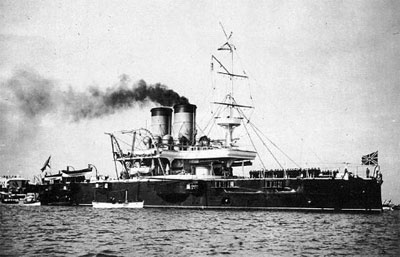
Fig. 1. Battleship «Yekaterina II». Built in Nikolayev in 1883—1886. Full load weight 10280 tons. Length — 103,5 m, width — 21 m. Power — 9100 hp. Speed — 15 kt. Crew team — 720 people. 23 cannons, 7 torpedo launchers. Experiments on wireless telegraphing have been carried out in 1901.
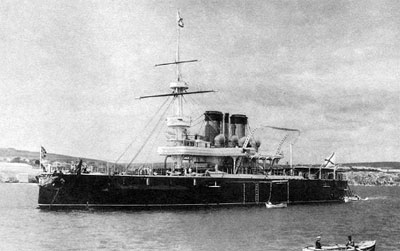
Fig. 2. Battleship «Sinop». Built in Sevastopol in 1883—1886. Full load weight 10280 tons. Length — 103,5 m, width — 21 m. Power — 13000 hp. Speed — 16 kt. Crew team — 720 people. 25 cannons, 7 torpedo launchers. Experiments on wireless telegraphing have been carried out in 1901.

Fig. 3. Mine cruiser «Kapitan Saken». Built in Nikolayev in 1886— 1889. Full load weight 742 tons. Length — 69,4 m, width — 7,3 m. Power — 2341 hp. Speed — 18,3 kt. Crew team — 127 people. 10 cannons, 3 torpedo launchers. Experiments on wireless telegraphing have been carried out in 1899 and 1901.
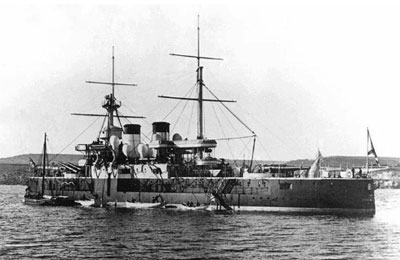
Fig. 4. Battleship «Dvenadtsat Apostolov». Built in Nikolayev in 1888—1890. Full load weight 8700 tons. Length — 104,2 m, width — 18,3 m. Power — 8750 hp. Speed — 15,7 kt. Crew team — 599 people. 22 cannons, 6 torpedo launchers. Experiments on wireless telegraphing have been carried out in 1899.
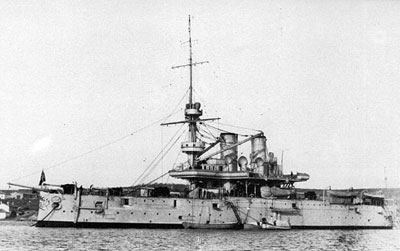
Fig. 5. Battleship «Georgy Pobedonosets». Built in Nikolayev in 1889—1892. Full load weight 10280 tons. Length — 103,5 m, width — 21 m. Power — 13000 hp. Speed — 16 kt. Crew team — 720 people. 51 cannons, 7 torpedo launchers. Experiments on wireless telegraphing have been carried out in 1899 and 1901.
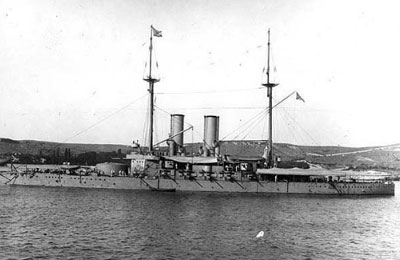
Fig. 6. Battleship «Tri Svyatitelya». Built in Nikolayev in 1891—1893. Full load weight 13300 tons. Length — 115,1 m, width — 22,2 m. Power — 11300 hp. Speed — 17 kt. Crew team — 731 people. 44 cannons, 6 torpedo launchers. Experiments on wireless telegraphing have been carried out in 1899.
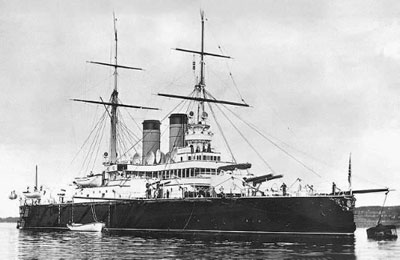
Fig. 7. Battleship «Rostislav». Built in Nikolayev in 1894—1896. Full load weight 10520 tons. Length — 107,2 m, width — 20,7 m. Power — 8816 hp. Speed — 15,8 kt. Crew team — 606 people. 42 cannons, 6 torpedo launchers. Experiments on wireless telegraphing have been carried out in 1901.
REFERENCES
- P. P. Yermolov, «Crimean historiography of A. S. Popov's a tivity», IEEE EUROCON 2009 Int. Conf. Devoted to the 150- anniversary of Alexander S. Popov, pp. 31-35, May 2009.
- P. P. Yermolov, Ye. A. Fedotov, A. S. Popov: Crimean Aspect, Sevastopol, Weber, 2010 (in Russian).
- Russian State Archive of the Navy, f. 421, inv. 4. case file 53, part 1, pp. 60-64 (in Russian).
- Russian State Archive of the Navy, f. 421, inv. 4. case file 53, part 2, pp. 13-15 (in Russian).
- L. I. Zolotinkina, M. A. Partala, V. A. Urvalov, Memorials of A. S. Popov's Life and Activity, Saint-Petersburg, LETI, 2008 (in Russian).
- A. M. Chikin, Sevastopol: Historical and Literature Guide, Sevastopol, Weber, 2007 (in Russian).
- Sevastopol: Encyclopedia, Simferopol, Salta, 2008 (in Russian).
- R. R. Bikkenin, A. A. Glushchenko, M. A. Partala, Essay about Signalmen of Russian Fleet, Saint-Petersburg, 1998 (in Russian).
Proc. of 2nd Region 8 IEEE Conference on the History of Telecommunications. Madrid, Spain, 3-5 November 2010. P. [135-140].
About writer: Sevastopol National Technical University, Radioengineering & Telecommunication dept 33, Universitetskaya str, Sevastopol, 99053, Ukraine. Popov Crimean Scientific and Technology Center P. O. Box 10, Sevastopol, 99057, Ukraine e-mail: 10.99057@gmail.com
16.12.2010



